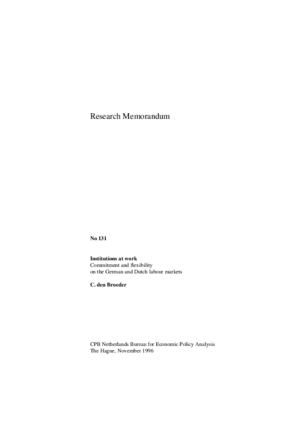Institutions at work; commitment and flexibility on the German and Dutch labour markets
This research memorandum analyses the relationship between labour market institutions and labour market performance. To this aim, it distinguishes two archetypical models of labour relations: the competitive model, which can be associated with the American labour market, and the cooperative model, which can be associated with labour relations in Germany. The strong points of both models differ.
The competitive model relies on freedom to act at the decentralized level to promote external flexibility. This improves allocative efficiency and the diffusion of knowledge. Moreover, individual discretion allows labour market conditions to reflect heterogeneous individual preferences or conditions. Finally, limited income protection provides strong incentives for search, job acceptance and investments in general rather than firm-specific human capital.
Institutions of the cooperative model, in contrast, strengthen commitment. Employers and workers keep to implicit agreements in labour relations and do not opportunistically exploit the other party's cooperative stance. This encourages a long-term view and stimulates investments in firm-specific assets. Moreover, consensus-building at a centralized level curbs local insider power, internalizes external effects and stabilizes labour relations. Finally, social insurance not only influences equity, but supports job search and insures investments in firm-specific human capital.
Based on this analytical framework, the paper addresses the position of German and Dutch labour market institutions on the trade-off between flexibility and commitment, choosing the United States as a benchmark. With respect to labour market regulations, the Dutch system results in a mix between commitment and flexibility, whereas the German system is closer to the cooperative model. Regarding wage formation, the Dutch system again results in a mix between commitment and flexibility. The German system, in contrast, does not fully capture the advantages of flexibility or commitment. Long-term economic trends in preferences, technological orientation, frequency and nature of economic shocks, degree of product market competition and heterogeneity result in a greater demand for both commitment and flexibility. This suggests that a mixed system will better be able than an extremely flexible or commitment-based system to deal with future economic challenges.
